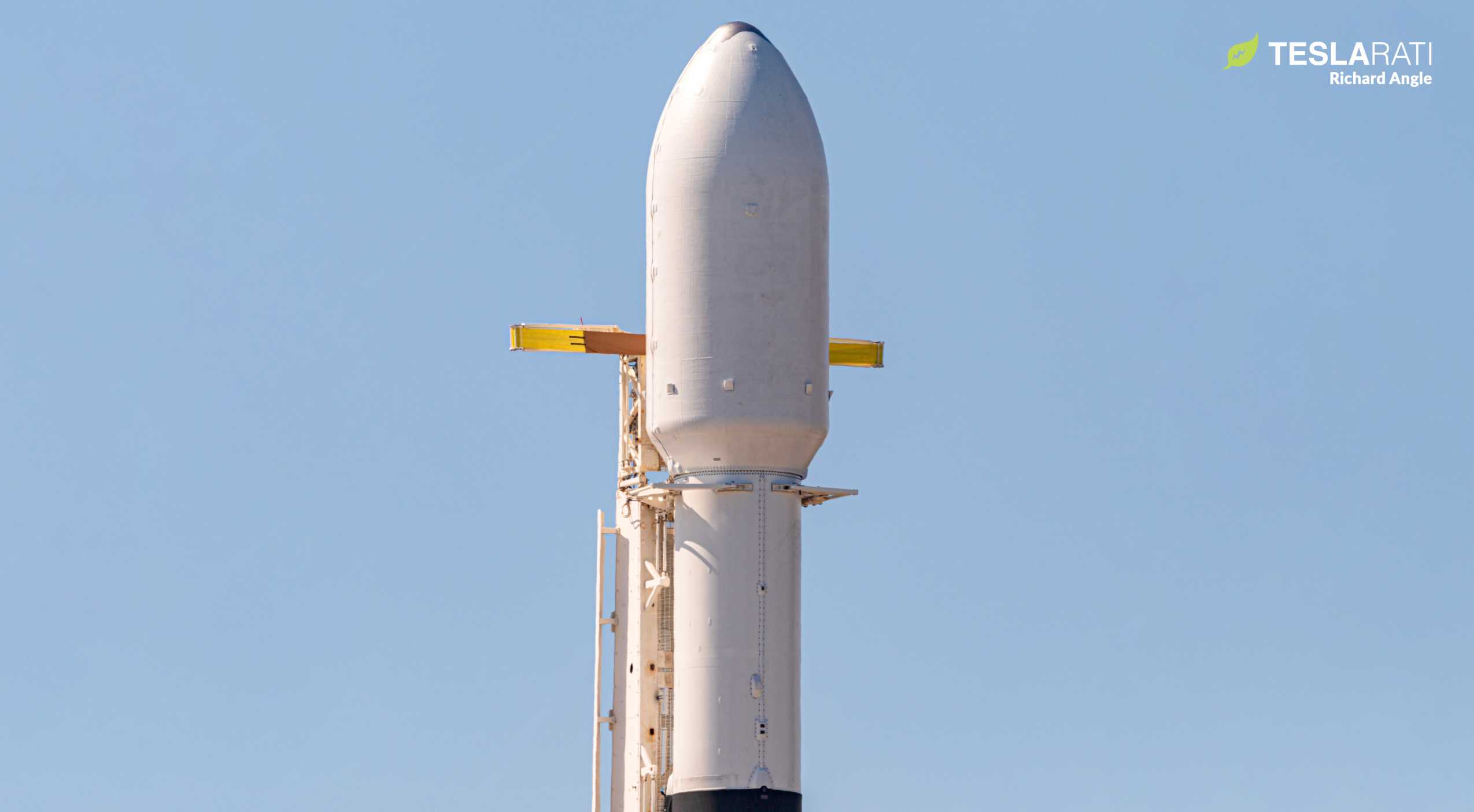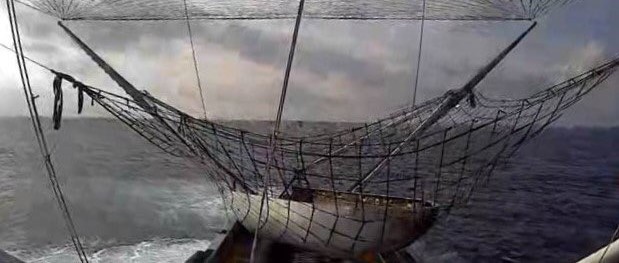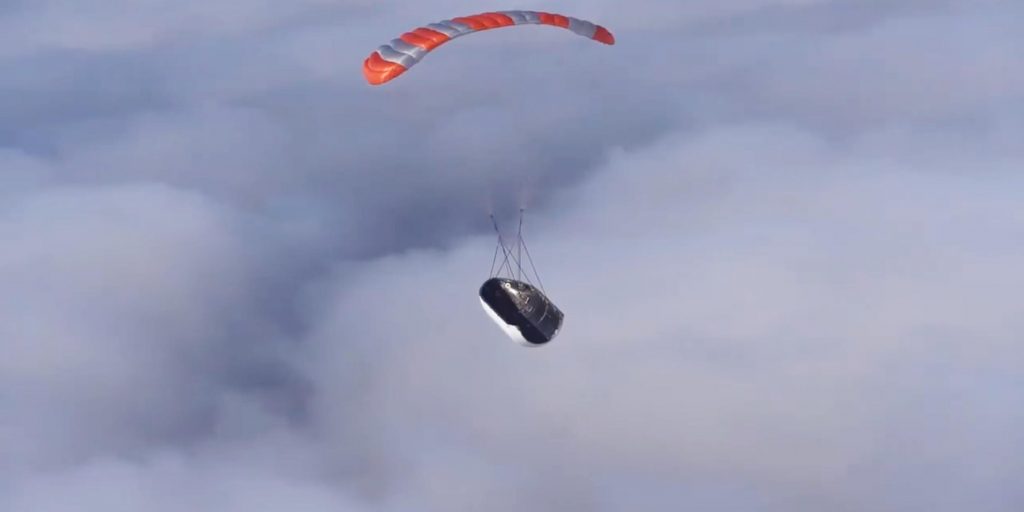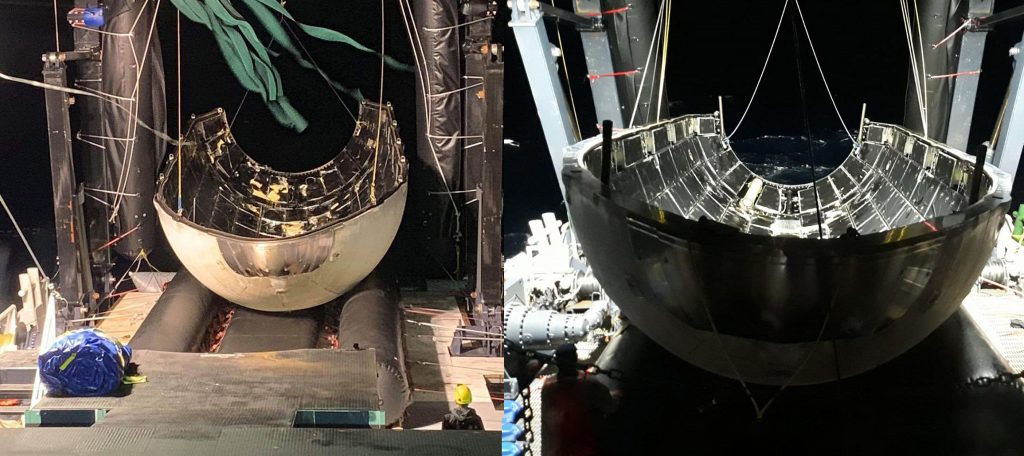

News
SpaceX may have missed a rocket booster landing but it snagged both nosecone halves
Although SpaceX sadly lost a record-breaking rocket booster and suffered a significant in-flight anomaly during its sixth Starlink launch, the company later revealed that it successfully recovered both of Falcon 9’s nosecone halves.
Starlink V1 L5 is now the second time ever that SpaceX – or anyone, for that matter – has successfully reused an orbital-class launch vehicle payload fairing, while the mission also marked the first time that SpaceX managed to recover a reused Falcon fairing. The burn from booster issues certainly isn’t fully salved, as twin fairing catchers Ms. Tree and Ms. Chief both missed their fairing catch attempts, but both twice-flown fairing halves were still successfully scooped out of the Atlantic Ocean before they were torn apart.
This is perhaps the most important milestone for SpaceX’s fairing recovery and reuse program since the first successful catch (June 2019) and first successful reuse (November 2019). With a twice-flown fairing now safely in hand for the first time, SpaceX will hopefully be able to dramatically expand its understanding of how flight-proven fairings – especially those that were fished out of the sea – stand up to launch conditions. If these flight-proven halves appear to be in great condition, it could be a boon for the near-term future of fairing recovery and reuse.

Catching fairings = hard
SpaceX has now been attempting to catch Falcon payload fairings for more than two years, beginning back in February 2018 after many months of additional development prior. The first successful catch came on the sixth post-launch attempt, followed immediately by a second successful catch two months later (August 2019). That back-to-back recovery appears to have been a bit of a fluke, however, with only one additional partial success (one of two ships caught a half) out of the five subsequent attempts.
By all appearances, accurately and reliably catching parasailing Falcon fairings is a spectacularly unforgiving challenge. That shouldn’t come as a huge surprise: each Falcon fairing will typically reach top speeds of 2.5+ km/s (1.5+ mi/s), technically reach space (100+ km or 63+ mi), and travel 500-1000+ km (300-600 mi) downrange before even remotely entering the vicinity of the ships designed to catch them out of the air.


Likely weighing just ~1000 kg (2200 lb) apiece, the lightweight, sail-like nature of SpaceX’s carbon fiber-aluminum honeycomb payload fairings is both a blessing and a curse. While it means they can effectively reenter Earth’s atmosphere at hypersonic velocities with next to no heat shield, it also means that free-falling and parasailing fairing halves are at the full mercy of said atmosphere after reentry, bowing to winds and air currents like dandelions in a breeze.
Fairing halves ultimately spend something like 30-40 minutes parasailing through the atmosphere after parafoil deployment, creating vast uncertainties when it comes to local weather and the general behavior of the atmosphere. Even excluding weather, the average fairing catch attempt is roughly akin to throwing an average marble into a kitchen sink from more than a kilometer (0.8 mi) away.

Soft ocean landings: quite a bit easier
What SpaceX has effectively discovered is that while catching fairing halves may be almost comically difficult, recovering the same halves intact is easily doable if the goal instead is to gently pick them up off the ocean surface. Of the eleven catch attempts SpaceX has made, all but two were followed by recovery vessels extracting one or both fairing halves -intact – from the ocean.
Most notably, though, SpaceX has yet to reuse any of the three Falcon fairing halves that were caught with Ms. Tree. Instead, both the first and second reuses used fairing halves that had been fished onto recovery ships after gentle Atlantic Ocean landings.

SpaceX has ultimately chosen to tackle the much harder reusability challenge – reusing fairings that have been partially immersed in saltwater – first, and done so quite successfully. Critically, the first reused fairing was unable to be recovered – even by sea – due to bad weather in the area, meaning that Wednesday’s recovery was a first for rare flight-proven fairing hardware. Given all the challenges Falcon fairings face with water sealing, corrosion, and contamination after water landings, it would be little surprise to learn that the second reused fairing is not exactly in pristine condition.
However, if it looks as good or better than SpaceX’s less-informed expectations, there’s a chance that it could open the floodgates for the full-scale pursuit of routine waterlogged fairing reuse. Even better, if the Starlink v0.9 and V1 L5 fairing halves have been recovered in great condition, there might be a chance to reuse Falcon fairings multiple times, following in the footsteps of the rocket boosters they launch on top of.
Check out Teslarati’s Marketplace! We offer Tesla accessories, including for the Tesla Cybertruck and Tesla Model 3.
Elon Musk
Tesla reveals it is using AI to make factories more sustainable: here’s how
Tesla is using AI in its Gigafactory Nevada factory to improve HVAC efficiency.

Tesla has revealed in its Extended Impact Report for 2024 that it is using Artificial Intelligence (AI) to enable its factories to be more sustainable. One example it used was its achievement of managing “the majority of the HVAC infrastructure at Gigafactory Nevada is now AI-controlled” last year.
In a commitment to becoming more efficient and making its production as eco-friendly as possible, Tesla has been working for years to find solutions to reduce energy consumption in its factories.
For example, in 2023, Tesla implemented optimization controls in the plastics and paint shops located at Gigafactory Texas, which increased the efficiency of natural gas consumption. Tesla plans to phase out natural gas use across its factories eventually, but for now, it prioritizes work to reduce emissions from that energy source specifically.
It also uses Hygrometric Control Logic for Air Handling Units at Giafactory Berlin, resulting in 17,000 MWh in energy savings each year. At Gigafactory Nevada, Tesla saves 9.5 GWh of energy through the use of N-Methylpyrrolidone refineries when extracting critical raw material.
Perhaps the most interesting way Tesla is conserving energy is through the use of AI at Gigafactory Nevada, as it describes its use of AI to reduce energy demand:
“In 2023, AI Control for HVAC was expanded from Nevada and Texas to now include our Berlin-Brandenburg and Fremont factories. AI Control policy enables HVAC systems within each factory to work together to process sensor data, model factory dynamics, and apply control actions that safely minimize the energy required to support production. In 2024, this system achieved two milestones: the majority of HVAC infrastructure at Gigafactory Nevada is now AI-controlled, reducing fan and thermal energy demand; and the AI algorithm was extended to manage entire chiller plants, creating a closed-loop control system that optimizes both chilled water consumption and the energy required for its generation, all while maintaining factory conditions.”
Tesla utilizes AI Control “primarily on systems that heat or cool critical factory production spaces and equipment.” AI Control communicates with the preexisting standard control logic of each system, and any issues can be resolved by quickly reverting back to standard control. There were none in 2024.
Tesla says that it is utilizing AI to drive impact at its factories, and it has proven to be a valuable tool in reducing energy consumption at one of its facilities.
Elon Musk
Tesla analysts believe Musk and Trump feud will pass
Tesla CEO Elon Musk and U.S. President Donald Trump’s feud shall pass, several bulls say.

Tesla analysts are breaking down the current feud between CEO Elon Musk and U.S. President Donald Trump, as the two continue to disagree on the “Big Beautiful Bill” and its impact on the country’s national debt.
Musk, who headed the Department of Government Efficiency (DOGE) under the Trump Administration, left his post in May. Soon thereafter, he and President Trump entered a very public and verbal disagreement, where things turned sour. They reconciled to an extent, and things seemed to be in the past.
However, the second disagreement between the two started on Monday, as Musk continued to push back on the “Big Beautiful Bill” that the Trump administration is attempting to sign into law. It would, by Musk’s estimation, increase spending and reverse the work DOGE did to trim the deficit.
Every member of Congress who campaigned on reducing government spending and then immediately voted for the biggest debt increase in history should hang their head in shame!
And they will lose their primary next year if it is the last thing I do on this Earth.
— Elon Musk (@elonmusk) June 30, 2025
President Trump has hinted that DOGE could be “the monster” that “eats Elon,” threatening to end the subsidies that SpaceX and Tesla receive. Musk has not been opposed to ending government subsidies for companies, including his own, as long as they are all abolished.
How Tesla could benefit from the ‘Big Beautiful Bill’ that axes EV subsidies
Despite this contentious back-and-forth between the two, analysts are sharing their opinions now, and a few of the more bullish Tesla observers are convinced that this feud will pass, Trump and Musk will resolve their differences as they have before, and things will return to normal.
ARK Invest’s Cathie Wood said this morning that the feud between Musk and Trump is another example of “this too shall pass:”
BREAKING: CATHIE WOOD SAYS — ELON AND TRUMP FEUD “WILL PASS” 👀 $TSLA
She remains bullish ! pic.twitter.com/w5rW2gfCkx
— TheSonOfWalkley (@TheSonOfWalkley) July 1, 2025
Additionally, Wedbush’s Dan Ives, in a note to investors this morning, said that the situation “will settle:”
“We believe this situation will settle and at the end of the day Musk needs Trump and Trump needs Musk given the AI Arms Race going on between the US and China. The jabs between Musk and Trump will continue as the Budget rolls through Congress but Tesla investors want Musk to focus on driving Tesla and stop this political angle…which has turned into a life of its own in a roller coaster ride since the November elections.”
Tesla shares are down about 5 percent at 3:10 p.m. on the East Coast.
Elon Musk
Tesla scrambles after Musk sidekick exit, CEO takes over sales
Tesla CEO Elon Musk is reportedly overseeing sales in North America and Europe, Bloomberg reports.

Tesla scrambled its executives around following the exit of CEO Elon Musk’s sidekick last week, Omead Afshar. Afshar was relieved of his duties as Head of Sales for both North America and Europe.
Bloomberg is reporting that Musk is now overseeing both regions for sales, according to sources familiar with the matter. Afshar left the company last week, likely due to slow sales in both markets, ending a seven-year term with the electric automaker.
Tesla’s Omead Afshar, known as Elon Musk’s right-hand man, leaves company: reports
Afshar was promoted to the role late last year as Musk was becoming more involved in the road to the White House with President Donald Trump.
Afshar, whose LinkedIn account stated he was working within the “Office of the CEO,” was known as Musk’s right-hand man for years.
Additionally, Tom Zhu, currently the Senior Vice President of Automotive at Tesla, will oversee sales in Asia, according to the report.
It is a scramble by Tesla to get the company’s proven executives over the pain points the automaker has found halfway through the year. Sales are looking to be close to the 1.8 million vehicles the company delivered in both of the past two years.
Tesla is pivoting to pay more attention to the struggling automotive sales that it has felt over the past six months. Although it is still performing well and is the best-selling EV maker by a long way, it is struggling to find growth despite redesigning its vehicles and launching new tech and improvements within them.
The company is also looking to focus more on its deployment of autonomous tech, especially as it recently launched its Robotaxi platform in Austin just over a week ago.
However, while this is the long-term catalyst for Tesla, sales still need some work, and it appears the company’s strategy is to put its biggest guns on its biggest problems.
-

 Elon Musk1 day ago
Elon Musk1 day agoTesla investors will be shocked by Jim Cramer’s latest assessment
-

 News6 days ago
News6 days agoTesla Robotaxi’s biggest challenge seems to be this one thing
-

 News2 weeks ago
News2 weeks agoTesla’s Grok integration will be more realistic with this cool feature
-

 Elon Musk2 weeks ago
Elon Musk2 weeks agoElon Musk slams Bloomberg’s shocking xAI cash burn claims
-

 News2 weeks ago
News2 weeks agoTesla China roars back with highest vehicle registrations this Q2 so far
-

 News2 weeks ago
News2 weeks agoTexas lawmakers urge Tesla to delay Austin robotaxi launch to September
-

 News2 weeks ago
News2 weeks agoTesla dominates Cars.com’s Made in America Index with clean sweep
-

 Elon Musk1 week ago
Elon Musk1 week agoFirst Look at Tesla’s Robotaxi App: features, design, and more




















